电子科技大学:《DSP算法实现技术与架构 VLSI Digital Signal Processing Systems Design and Implementation》课程教学资源(课件讲稿)Chapter 08 快速卷积 Fast Convolution
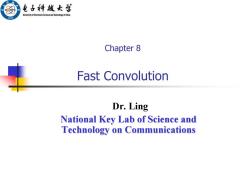
电子种越女学 University of Electroale Science and Technelery of China 986 Chapter 8 Fast Convolution Dr.Ling National Key Lab of Science and Technology on Communications
Chapter 8 Fast Convolution Dr. Ling National Key Lab of Science and Technology on Communications
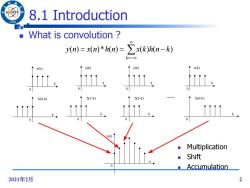
8.1 Introduction 986 What is convolution 00 y(n)=x(n)*h(n)=>x(k)h(n-k) k=-00 x(k) ↑x(k) ↑x(k) x(k) h(0-k) h(1-k) h(2-k) h(6-k) 0 y(n) Multiplication Shift n ■Accumulation 2021年2月 2
2021年2月 2 k k 0 0 x(k) h(0-k) k k 0 0 x(k) h(1-k) k k 0 0 x(k) h(2-k) k k 0 0 x(k) h(6-k) n y(n) 0 …… 8.1 Introduction Multiplication Shift Accumulation What is convolution ? k y(n) x(n)*h(n) x(k)h(n k)
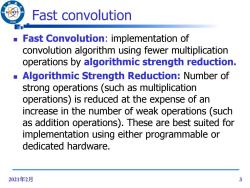
Fast convolution /96 Fast Convolution:implementation of convolution algorithm using fewer multiplication operations by algorithmic strength reduction. Algorithmic Strength Reduction:Number of strong operations(such as multiplication operations)is reduced at the expense of an increase in the number of weak operations (such as addition operations).These are best suited for implementation using either programmable or dedicated hardware. 2021年2月 3
2021年2月 3 Fast convolution Fast Convolution: implementation of convolution algorithm using fewer multiplication operations by algorithmic strength reduction. Algorithmic Strength Reduction: Number of strong operations (such as multiplication operations) is reduced at the expense of an increase in the number of weak operations (such as addition operations). These are best suited for implementation using either programmable or dedicated hardware
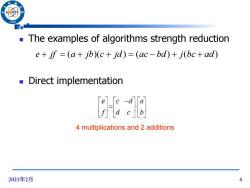
966 The examples of algorithms strength reduction e+if=(a+jb)(c+jd)=(ac-bd)+j(bc+ad) Direct implementation 调 4 multiplications and 2 additions 2021年2月 4
2021年2月 4 The examples of algorithms strength reduction Direct implementation e jf (a jb)(c jd ) (ac bd) j(bc ad) 4 multiplications and 2 additions
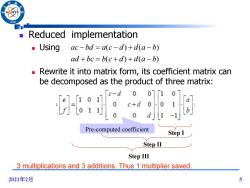
/966 Reduced implementation Using ac-bd a(c-d)+d(a-b) ad+bc=b(c+d)+d(a-b) Rewrite it into matrix form,its coefficient matrix can be decomposed as the product of three matrix: 世服胸 Pre-computed coefficient Step I Step IⅢ Step III 3 multiplications and 3 additions.Thus 1 multiplier saved. 2021年2月 5
2021年2月 5 Reduced implementation Using Rewrite it into matrix form, its coefficient matrix can be decomposed as the product of three matrix: ( ) ( ) ( ) ( ) ad bc b c d d a b ac bd a c d d a b 3 multiplications and 3 additions. Thus 1 multiplier saved. Pre-computed coefficient Step I Step II Step III
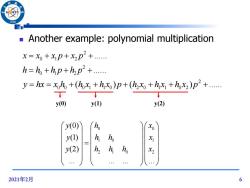
/96 Another example:polynomial multiplication X=x0+X1p+X2p2+. h=ho+hp+hp+..... y=hx=xoho+(hohx)p+(h2x++hox2)p2+..... y(0) y(1) y(2) y(0) Xo y() h h 水 y(2) h h h X2 2021年2月 6
2021年2月 6 Another example: polynomial multiplication 2 0 1 2 2 0 1 2 2 0 0 0 1 1 0 2 0 1 1 0 2 ...... ...... ( ) ( ) ...... x x x p x p h h h p h p y hx x h h x h x p h x h x h x p y(0) y(1) y(2) 0 0 1 0 1 2 1 0 2 (0) (1) (2) ... ... ... ... y h x y h h x y h h h x
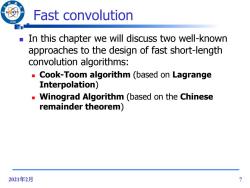
Fast convolution /96 In this chapter we will discuss two well-known approaches to the design of fast short-length convolution algorithms: ■ Cook-Toom algorithm (based on Lagrange Interpolation) Winograd Algorithm (based on the Chinese remainder theorem) 2021年2月 7
2021年2月 7 Fast convolution In this chapter we will discuss two well-known approaches to the design of fast short-length convolution algorithms: Cook-Toom algorithm (based on Lagrange Interpolation) Winograd Algorithm (based on the Chinese remainder theorem)
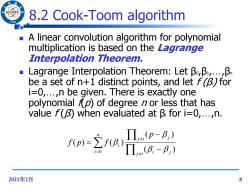
8.2 Cook-Toom algorithm /96 A linear convolution algorithm for polynomial multiplication is based on the Lagrange Interpolation Theorem. Lagrange Interpolation Theorem:Letβo,β:,..β be a set of n+1 distinct points,and let f()for i=0,...,n be given.There is exactly one polynomial p)of degree n or less that has value f(B)when evaluated at B for i=0,...,n. (p-B,) fp)=fBA,)T.B-B,) 2021年2月 8
2021年2月 8 8.2 Cook-Toom algorithm A linear convolution algorithm for polynomial multiplication is based on the Lagrange Interpolation Theorem. Lagrange Interpolation Theorem: Let β0,β1,…,βn be a set of n+1 distinct points, and let f (βi) for i=0,…,n be given. There is exactly one polynomial f(p) of degree n or less that has value f (βi) when evaluated at βi for i=0,…,n. n i j i i j j i j i p f p f 0 ( ) ( ) ( ) ( )
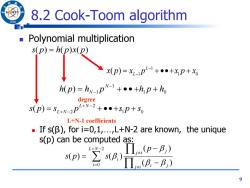
8.2 Cook-Toom algorithm 96 Polynomial multiplication s(p)=h(p)x(p) x(p)=x-1p-+●+xp+x0 h(p)=hw-1pN-+●●+hp+h degree s(p)=2+N-2D+N2++Sp+S0 L+N-1 coefficients If s(B),for i=0,1,...,L+N-2 are known,the unique s(p)can be computed as: L+N-2 s(p)=∑s(B,) Πp-B) i=0 Π(B,-B,) 9
9 8.2 Cook-Toom algorithm s( p) h( p)x( p) 1 0 1 1 h( p) h p h p h N N 1 1 1 0 ( ) L L x p x p x p x 2 2 1 0 ( ) L N L N s p s p s p s 2 0 ( ) ( ) ( ) ( ) L N i j i i j j i j i p s p s Polynomial multiplication If s(βi), for i=0,1,…,L+N-2 are known, the unique s(p) can be computed as: degree L+N-1 coefficients
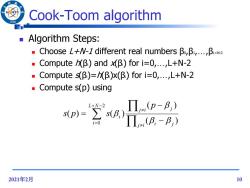
Cook-Toom algorithm 96 Algorithm Steps: ■Choose L+W-1 different real numbersβ,β,..,B+w2 Compute/B)and x(B)for i=0,...,L+N-2 ■Compute s(β)=hβ)x(β)fori=0,..,L+N-2 Compute s(p)using Π(p-B;) sp)=空g)7iB,-B L+N-2 i=0 2021年2月 10
2021年2月 10 Cook-Toom algorithm Algorithm Steps: Choose L+N-1 different real numbers β0,β1,…,βL+N-2 Compute h(βi) and x(βi) for i=0,…,L+N-2 Compute s(βi)=h(βi)x(βi) for i=0,…,L+N-2 Compute s(p) using 2 0 ( ) ( ) ( ) ( ) L N i j i i j j i j i p s p s
按次数下载不扣除下载券;
注册用户24小时内重复下载只扣除一次;
顺序:VIP每日次数-->可用次数-->下载券;
- 电子科技大学:《DSP算法实现技术与架构 VLSI Digital Signal Processing Systems Design and Implementation》课程教学资源(课件讲稿)Chapter 10 递归滤波器 Pipelined and Parallel Recursive and Adaptive Filters.pdf
- 电子科技大学:《DSP算法实现技术与架构 VLSI Digital Signal Processing Systems Design and Implementation》课程教学资源(课件讲稿)Chapter 07 脉动阵列 Systolic Architecture.pdf
- 电子科技大学:《DSP算法实现技术与架构 VLSI Digital Signal Processing Systems Design and Implementation》课程教学资源(课件讲稿)Chapter 06 折叠 Folding.pdf
- 电子科技大学:《DSP算法实现技术与架构 VLSI Digital Signal Processing Systems Design and Implementation》课程教学资源(课件讲稿)Chapter 05 展开 Unfolding.pdf
- 电子科技大学:《DSP算法实现技术与架构 VLSI Digital Signal Processing Systems Design and Implementation》课程教学资源(课件讲稿)Chapter 04 重定时 Retiming.pdf
- 电子科技大学:《DSP算法实现技术与架构 VLSI Digital Signal Processing Systems Design and Implementation》课程教学资源(课件讲稿)Chapter 03 流水与并行 Pipelining and Parallel Processing.pdf
- 电子科技大学:《DSP算法实现技术与架构 VLSI Digital Signal Processing Systems Design and Implementation》课程教学资源(课件讲稿)Chapter 02 迭代界 Iteration Bound.pdf
- 电子科技大学:《DSP算法实现技术与架构 VLSI Digital Signal Processing Systems Design and Implementation》课程教学资源(课件讲稿)Chapter 01 导论 Introduction to Digital Signal Processing Systems.pdf
- 电子科技大学:《DSP算法实现技术与架构 VLSI Digital Signal Processing Systems Design and Implementation》课程教学资源(课件讲稿)Chapter 00 简介 Introduction to VLSI(凌翔).pdf
- 电子科技大学:《DSP算法实现技术与架构 VLSI Digital Signal Processing Systems Design and Implementation》课程教学资源(教学大纲,凌翔).pdf
- 电子科技大学:《电子无源元件工艺实验》课程实验课件讲稿 Electronic Passive Components Process Experiment Course(主讲:戴丽萍).pdf
- 电子科技大学:《半导体封装测试与可靠性 Packaging,Testing and Reliability of Semiconductor》课程教学资源(课件讲稿,思政版).pdf
- 电子科技大学:《半导体封装测试与可靠性 Packaging,Testing and Reliability of Semiconductor》课程教学资源(教学大纲,思政版).pdf
- 电子科技大学:《ASIC设计 Application Specific Integrated Circuit Design》课程教学资源(课件讲稿)Topic 4 VLSI for DSP.pdf
- 电子科技大学:《ASIC设计 Application Specific Integrated Circuit Design》课程教学资源(课件讲稿)Topic 3 Verification and Test.pdf
- 电子科技大学:《ASIC设计 Application Specific Integrated Circuit Design》课程教学资源(课件讲稿)Topic 2.2 FPGA Design with Verilog(Supplementary).pdf
- 电子科技大学:《ASIC设计 Application Specific Integrated Circuit Design》课程教学资源(课件讲稿)Topic 2.1 FPGA Design with Verilog(FPGA Design Method、Design Examples).pdf
- 电子科技大学:《ASIC设计 Application Specific Integrated Circuit Design》课程教学资源(课件讲稿)Topic 1.3 Introduction-Our Course.pdf
- 电子科技大学:《ASIC设计 Application Specific Integrated Circuit Design》课程教学资源(课件讲稿)Topic 1.2 Introduction-ASIC Design.pdf
- 电子科技大学:《ASIC设计 Application Specific Integrated Circuit Design》课程教学资源(课件讲稿)Topic 1.1 Introduction-IC technology.pdf
- 电子科技大学:《DSP算法实现技术与架构 VLSI Digital Signal Processing Systems Design and Implementation》课程教学资源(课件讲稿)Chapter 09 算法强度缩减 Algorithmic strength reduction in filters and transforms.pdf
- 电子科技大学:《DSP算法实现技术与架构 VLSI Digital Signal Processing Systems Design and Implementation》课程教学资源(课件讲稿)Chapter 11 缩放噪声 Scaling and Roundoff Noise.pdf
- 电子科技大学:《DSP算法实现技术与架构 VLSI Digital Signal Processing Systems Design and Implementation》课程教学资源(课件讲稿)Chapter 13 位级运算 Bit-Level Arithmetic Architectures.pdf
- 电子科技大学:《DSP算法实现技术与架构 VLSI Digital Signal Processing Systems Design and Implementation》课程教学资源(课件讲稿)Chapter 14 冗余运算 Redundant Arithmetic.pdf
- 电子科技大学:《DSP算法实现技术与架构 VLSI Digital Signal Processing Systems Design and Implementation》课程教学资源(课件讲稿)Chapter 15 数字强度缩减 Numerical Strength Reduction.pdf
- 电子科技大学:《集成电路可测性设计 VLSIDesign》课程教学资源(课件讲稿)第1章 概述——研究意义(王忆文).pdf
- 电子科技大学:《集成电路可测性设计 VLSIDesign》课程教学资源(课件讲稿)第1章 概述——测试的基本知识.pdf
- 电子科技大学:《集成电路可测性设计 VLSIDesign》课程教学资源(课件讲稿)第2章 电路测试基础.pdf
- 电子科技大学:《集成电路可测性设计 VLSIDesign》课程教学资源(课件讲稿)第3章 验证、模拟和仿真.pdf
- 电子科技大学:《集成电路可测性设计 VLSIDesign》课程教学资源(课件讲稿)第4章 自动测试生成.pdf
- 电子科技大学:《集成电路可测性设计 VLSIDesign》课程教学资源(课件讲稿)第10章 电流测试.pdf
- 电子科技大学:《集成电路可测性设计 VLSIDesign》课程教学资源(课件讲稿)第11章 存储器测试.pdf
- 电子科技大学:《集成电路可测性设计 VLSIDesign》课程教学资源(课件讲稿)第12章 Soc测试(1/2).pdf
- 电子科技大学:《集成电路可测性设计 VLSIDesign》课程教学资源(课件讲稿)第5章 专用可测性设计.pdf
- 电子科技大学:《集成电路可测性设计 VLSIDesign》课程教学资源(课件讲稿)第6章 扫描设计.pdf
- 电子科技大学:《集成电路可测性设计 VLSIDesign》课程教学资源(课件讲稿)第7章 边界扫描.pdf
- 电子科技大学:《集成电路可测性设计 VLSIDesign》课程教学资源(课件讲稿)第8、9章 内建自测试.pdf
- 电子科技大学:《集成电路可测性设计 VLSIDesign》课程教学资源(课件讲稿)第12章 Soc测试(2/2)IEEE P1500 嵌入式核可测性标准.pdf
- 《现代编码理论与技术》课程教学资源(学习资料)Turbo码启示录——从默默无闻到广泛应用.doc
- 华南理工大学:《现代编码理论与技术》课程教学资源(讲义)第三章 线性分码组.doc
